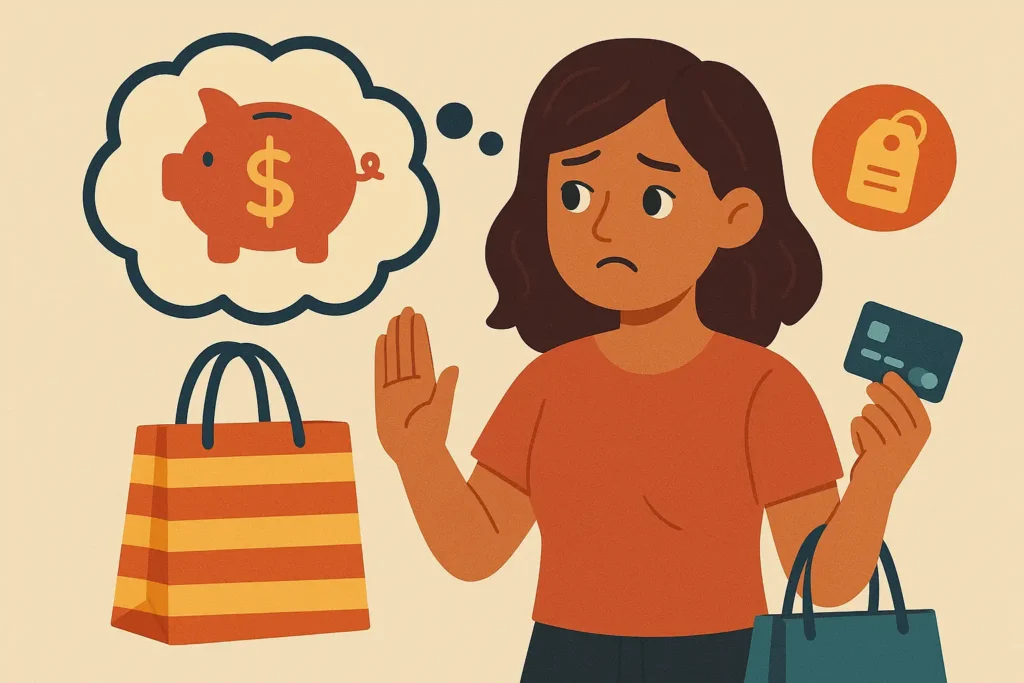Have you ever found yourself with shopping bags or an online cart full of items you hadn’t planned to buy? You’re not alone. Impulse buying affects nearly 84% of Americans, with the average person spending over $2,100 annually on unplanned purchases. This comprehensive guide explores the psychological mechanisms driving these spontaneous purchases and provides practical, science-backed strategies to help you transform your spending habits and make more mindful financial decisions.
Understanding Why We Make Impulsive Purchases
Impulse buying isn’t simply a lack of willpower—it’s a complex psychological process influenced by your environment, emotions, and even neurochemistry. When you make an unplanned purchase, your brain releases dopamine, creating a temporary sense of pleasure and reward. This neurological response can create a cycle that’s challenging but entirely possible to break with the right approach.
Read our article on Abundance vs Scarcity mindset
What is Impulse Purchase Cycle?
The Impulse Purchase Cycle is the psychological process a consumer goes through when making a spontaneous, unplanned purchase. It typically includes five stages: exposure to the product, emotional response, desire formation, quick justification, and immediate purchase decision. This cycle is often triggered by emotions, urgency, or product placement rather than rational planning.
Understanding the impulse purchase cycle is crucial because awareness is the first step toward breaking harmful patterns. Recognizing when you’re entering this cycle gives you the opportunity to pause and make a more conscious decision.
Three Phases of the Impulse Purchase Cycle
The complete impulse purchase cycle consists of seven distinct phases that explain why we make unplanned purchases. Let’s explore three critical phases that, once understood, can help you interrupt the cycle:
1. Exposure and Triggering
The impulse purchase cycle begins when you encounter a product, often unexpectedly. Retailers strategically place items to maximize this exposure—think candy at checkout lines or “recommended for you” sections online. During this phase, something catches your attention and triggers desire. This trigger could be visual appeal, perceived scarcity (“limited time offer”), or emotional state (shopping when sad or celebrating).
Why this matters: Your brain processes these triggers before your conscious mind can intervene, creating an immediate desire response. Research from the Journal of Consumer Psychology shows that simply being exposed to products activates the brain’s reward centers, making impulse purchases more likely.
To stop impulse buying at this phase, limit your exposure to shopping environments when unnecessary. Unsubscribe from marketing emails, avoid browsing online stores when bored, and have a specific list when shopping.
2. Urge Intensification and Rationalization
Once triggered, the urge to purchase intensifies rapidly. This is when your brain begins working overtime to justify the unplanned purchase. Common rationalizations include:
- “I might need this later”
- “It’s such a good deal”
- “I work hard and deserve a treat”
This phase is particularly powerful because it hijacks rational thinking. Your brain generates convenient reasons why this impulse purchase is actually a good decision, despite contradicting your budget or goals.
To combat impulse buying at this stage, implement a mandatory waiting period. For smaller purchases, wait 24 hours; for larger ones, wait a week. This cooling-off period often reveals that the “urgent need” was merely a temporary desire.
3. Post-Purchase Evaluation
After making an impulse purchase, you enter the evaluation phase, where you assess whether the item was worth buying. This often involves conflicting emotions—initial satisfaction followed by buyer’s remorse. Many impulse buyers experience regret, guilt, or anxiety about their decision, especially if it causes financial strain.
This phase is crucial for learning, as it can either reinforce the behavior (“I love this purchase!”) or create resolve to stop impulse buying in the future. Keep a “purchase journal” documenting how you feel about impulse buys days or weeks later to build awareness of patterns.
What are some Things that Tempt you to Spend Impulsively or Without Having Planned to Spend?
Understanding your personal triggers is essential to stop impulse buying. Here are common temptations that researchers have identified:
Emotional States
Many turn to shopping when experiencing strong emotions—both positive and negative. Shopping while celebrating can lead to extravagant purchases, while “retail therapy” during sadness can temporarily boost mood. Boredom is another powerful driver, with many browsing online stores simply to pass time.
A study from the Journal of Consumer Psychology found that sadness increases spending by up to 30%, as people unconsciously try to boost their self-image through purchases.
Environmental Cues
Retailers are experts at creating environments that encourage impulse buying. Sales signs, limited-time offers, and strategically placed “complementary” items all tap into our fear of missing out. Online shopping platforms use personalized recommendations and countdown timers to create urgency.
Social Influence
Social media has intensified impulse buying through influencer marketing, unboxing videos, and the constant exposure to what others are purchasing. The desire to keep up with trends or match a lifestyle portrayed online can trigger unplanned purchases.
Accessibility and Convenience
The ease of one-click ordering, saved payment information, and 24/7 shopping access has removed many barriers that once gave us time to reconsider impulse buys. The frictionless nature of modern shopping makes it easier than ever to make unplanned purchases.
To effectively stop impulse buying, identify which of these temptations most affects you. For some, it might be emotional shopping; for others, sales and discounts are irresistible. Tailoring your prevention strategies to your specific triggers greatly increases success.
Science-Backed Strategies to Stop Impulse Buying
Breaking the impulse purchase cycle requires a personalized approach that addresses your specific triggers and shopping patterns. Recent advances in behavioral science now make it possible to create a customized plan that works with your unique psychology rather than against it.
Identify Your Personal Impulse Buying Pattern
The first step in stopping impulse buying is gaining awareness of your specific patterns. AI tools can help uncover insights you might miss on your own through structured self-reflection.
AI Prompt To Copy/Paste:
“I want to understand my impulse buying patterns better. Please act as a behavioral science expert to help me analyze my spending habits and create a personalized prevention plan.
Please guide me through this process step by step, waiting for my response before moving to each next stage:
First Step: Pattern Identification
- When was the last time you made an impulse purchase? a. Example: “Last week, I bought shoes I hadn’t planned to buy.”
- What triggered the purchase (sale, advertisement, browsing, emotion)? a. Example: “I saw a 40% off sale notification in my email.”
- Where and when do most of your unplanned purchases happen? a. Example: “Usually online, in the evenings after work.”
Second Step: Strategy Development Based on your answers, I’ll recommend three customized strategies to:
- Modify your environment to reduce triggers
- Create a decision firewall for when you feel the urge to buy
- Develop alternative activities that satisfy the same emotional needs
Third Step: Implementation Plan
I’ll help you create a simple 14-day plan to put these strategies into action, with specific steps to follow when you encounter shopping triggers.”
Using this AI prompt can help you quickly identify your personal impulse buying patterns and develop targeted interventions that address your specific challenges.
How to Stop Impulse Buying
Create a Financial Firewall
Establishing structured financial boundaries protects you from impulse buying. Implement a mandatory waiting period—24 hours for small purchases and a week for larger ones. This cooling-off period allows initial excitement to fade, enabling rational evaluation. Use cash for discretionary spending, as studies show people spend 12-18% less with physical currency due to the heightened “pain of paying.” Remove saved payment information online and create separate accounts for different spending categories to further compartmentalize your finances and track exactly where your money goes.
Read More: Better Money Habits
Transform Your Shopping Environment
Your surroundings profoundly influence spending behavior. Start by systematically eliminating shopping triggers. Unsubscribe from retail marketing emails and notifications, which can reduce temptation exposure by up to 70%. Install website blockers or app timers for online shopping platforms. When shopping, bring a specific list and commit to it—this practice alone reduces unplanned purchases by up to 40%. Shop after meals, as research shows hunger increases acquisition desire, even for non-food items. Avoid shopping when emotionally vulnerable, as these states impair decision-making.
Develop Emotional Regulation Strategies
Many impulse purchases stem from using shopping as emotional regulation—”retail therapy.” While momentarily effective at boosting mood, this often leads to financial strain and negative emotions. Develop alternative methods for managing emotional states. When feeling stressed, anxious, or bored, try brief meditation, physical activity, or deep breathing exercises. These trigger similar pleasure responses without financial consequences. Keep a list of specific non-shopping activities that fulfill different emotional needs—calling a friend when seeking connection, engaging in a creative hobby when bored, or exercising when stressed.
Read More: How to Increase Will Power
Implement Mindful Consumption Practices
In order to stop impulsive shopping Mindfulness is very important. Mindfulness transforms your relationship with spending. Studies show mindful consumers make fewer impulse purchases and report greater satisfaction with necessary purchases. Develop a pre-purchase questioning ritual: “Do I truly need this or just want it momentarily?” “Will this bring value a month from now?” “How does this align with my financial goals?” These questions activate your prefrontal cortex—the brain’s executive function center—helping overcome impulses. Practice gratitude for items you already own, as research demonstrates this reduces materialistic tendencies and increases contentment.
Read More: How to Clear your Mind with Meditation
Leverage Technology Mindfully
While technology facilitates impulse buying, it can also support mindful spending. Budgeting apps provide immediate feedback on spending patterns, helping identify trigger categories. Some financial applications automatically transfer small amounts to savings when detecting potential impulse buys, transforming spending urges into wealth-building. Browser extensions can hide shopping sites during work hours or display financial goals when visiting retail websites. Banking apps with cooling-off periods or secondary approval requirements create digital spending firewalls protecting you from momentary urges.
Build Social Accountability Systems
Human connection provides powerful motivation for behavior change. Research shows publicly committing to goals significantly increases follow-through. Share your intention to reduce impulse buying with supportive friends or family. Find a “financial accountability partner” with similar goals and establish regular check-ins to discuss progress. Consider joining communities focused on intentional consumption, such as minimalist groups or financial independence forums. These communities normalize mindful spending and provide practical strategies from those who have successfully overcome impulse buying habits.
Read More: Is Life Worth Living
Seeking Support to Stop Impulse Buying
Breaking entrenched shopping habits often requires support. Consider:
Accountability Partners
Share your goal to stop impulse buying with someone who can check in on your progress and offer encouragement. Being accountable to someone else adds a layer of motivation.
Professional Help
If impulse buying has led to significant debt or causes extreme distress, consider working with a financial therapist or counselor. Compulsive shopping can sometimes be related to underlying issues like anxiety or depression.
Read more: How to Find a Life Coach
Community Resources
Join online communities focused on mindful spending, debt reduction, or minimalism. These groups provide motivation, practical tips, and the knowledge that you’re not alone in your efforts to stop impulse buying.
Conclusion: How to Stop Impulse Buying
The path to stop impulse buying isn’t about deprivation—it’s about making intentional choices aligned with what truly matters to you. By understanding your personal impulse purchase cycle, identifying your unique triggers, and implementing personalized strategies, you can transform your relationship with spending.
Remember that occasional slips don’t mean failure—building new habits takes time. Each time you successfully resist an impulse purchase, you strengthen neural pathways that make future resistance easier. With practice, mindful spending becomes less of a conscious effort and more of a natural approach to consumption.
If you’re ready to take your transformation to the next level, consider a more comprehensive approach. The Habits Coach AI offers a personalized, science-based framework that gamifies the habit-building process, making it easier and more enjoyable to develop positive financial habits. By combining behavioral science with engaging technology, it helps you replace impulse spending with healthier habits that align with your true goals.
Take our free Core Values Quiz to get a personalized assessment of where you currently stand in all 5 Cores, including your financial habits, and discover the first step to building momentum and GAMIFYING LIFE.
By taking control of impulse buying, you’re not just saving money—you’re reclaiming your power to choose what truly deserves your hard-earned resources. This shift brings not only financial benefits but also greater satisfaction with the purchases you do make.
Ready to start your journey toward mindful spending? Begin with the AI prompt above today and experience the difference that personalized, science-backed strategies can make.






